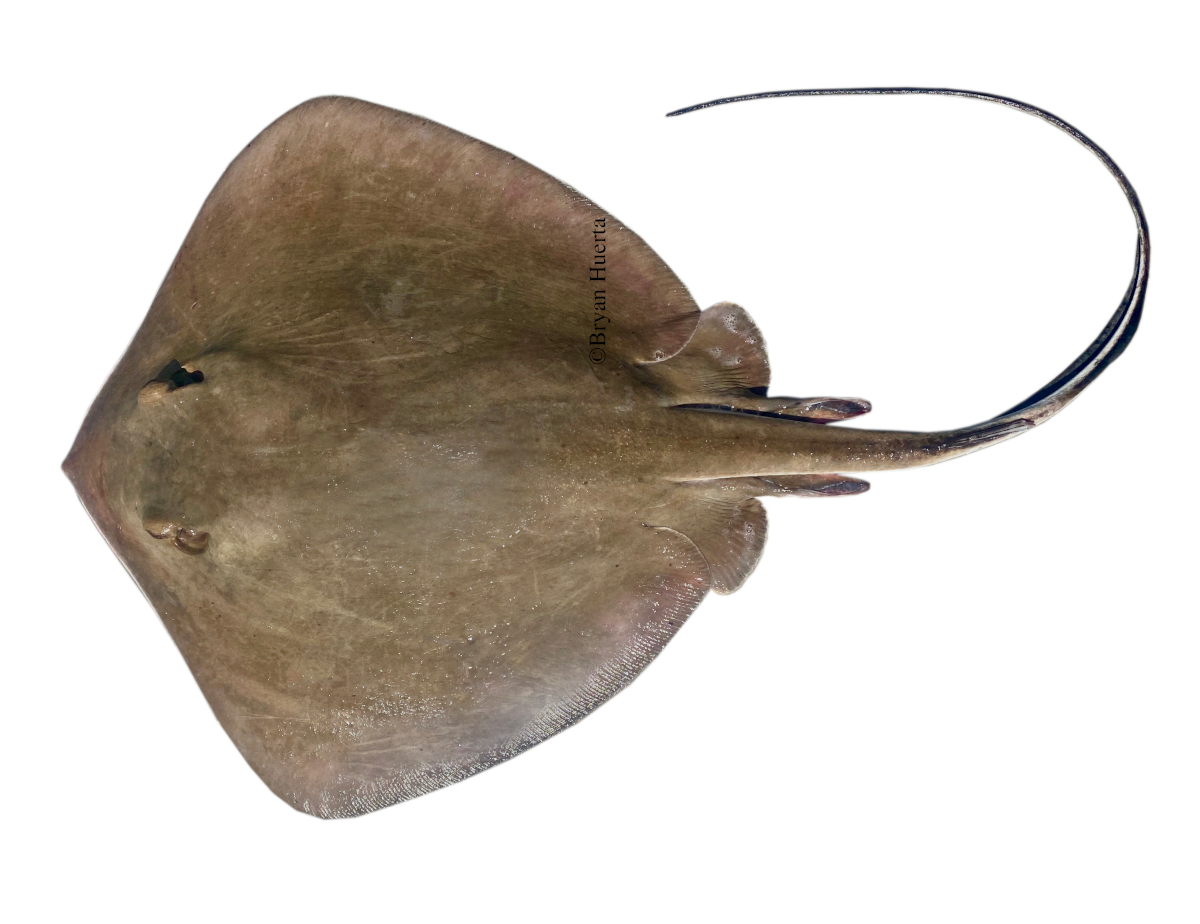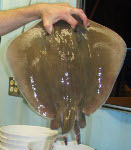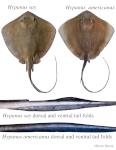Hypanus say
(Lesueur, 1817)
Bluntnose stingray
Classification: Elasmobranchii Myliobatiformes Dasyatidae
Reference of the original description
Description of three new species of the genus Raja. Journal of the Academy of Natural Sciences of Philadelphia, 1(ser. 1), 41–45
Description of three new species of the genus Raja. Journal of the Academy of Natural Sciences of Philadelphia, 1(ser. 1), 41–45
Image of the original description
No image in first description.
No image in first description.
Synonyms / new combinations and misspellings
Amphotistius say, Dasibatis sayi, Dasyatis say, Dasyatis sayi, Dasybatus say, Dasybatus sayi, Myliobatis say, Raja say, Trygon sayi, Trygon (Trygon) sayi
Amphotistius say, Dasibatis sayi, Dasyatis say, Dasyatis sayi, Dasybatus say, Dasybatus sayi, Myliobatis say, Raja say, Trygon sayi, Trygon (Trygon) sayi
Description :
Citation: Hypanus say (Lesueur, 1817): In: Database of modern sharks, rays and chimaeras, www.shark-references.com, World Wide Web electronic publication, Version 01/2026
Please send your images of "Hypanus say" to info@shark-references.com

Hypanus say (Lesueur, 1817), male, northern Gulf of Mexico © Bryan Huerta

Hypanus say (Lesueur, 1817), male, northern Gulf of Mexico © Bryan Huerta
Common names
 Stumpfnasenstechrochen,
Stumpfnasenstechrochen,  Chucho,
Chucho,  Raya,
Raya,  Raya hocicona,
Raya hocicona,  Raya látigo chata,
Raya látigo chata,  Raya mediana,
Raya mediana,  Blunmose Stingray,
Blunmose Stingray,  Bluntnose stingray,
Bluntnose stingray,  Say"s stingray,
Say"s stingray,  Arraia-amarela,
Arraia-amarela,  Arraia-manteiga,
Arraia-manteiga,  Manteiga,
Manteiga,  Raia,
Raia,  Raia amarela,
Raia amarela,  Raia chita,
Raia chita,  Raia mijona,
Raia mijona,  Raia prego,
Raia prego,  Raia-manteiga
Raia-manteiga
 Stumpfnasenstechrochen,
Stumpfnasenstechrochen,  Chucho,
Chucho,  Raya,
Raya,  Raya hocicona,
Raya hocicona,  Raya látigo chata,
Raya látigo chata,  Raya mediana,
Raya mediana,  Blunmose Stingray,
Blunmose Stingray,  Bluntnose stingray,
Bluntnose stingray,  Say"s stingray,
Say"s stingray,  Arraia-amarela,
Arraia-amarela,  Arraia-manteiga,
Arraia-manteiga,  Manteiga,
Manteiga,  Raia,
Raia,  Raia amarela,
Raia amarela,  Raia chita,
Raia chita,  Raia mijona,
Raia mijona,  Raia prego,
Raia prego,  Raia-manteiga
Raia-manteiga
Short Description
Moderate size, with a short blunt snout. Disk has rounded corners, few tubercles and spines along midline [17659]. Well developed fold on the upper surface and lower surface of tail. Yellowish or light brown above. Lower surface whitish or pure white [199].
Moderate size, with a short blunt snout. Disk has rounded corners, few tubercles and spines along midline [17659]. Well developed fold on the upper surface and lower surface of tail. Yellowish or light brown above. Lower surface whitish or pure white [199].
Distribution
Western Atlantic: New Jersey (rarely in Massachusetts), USA and northern Gulf of Mexico to Argentina; widespread in the West Indies. Throughout Antilles [17659].
Western Atlantic: New Jersey (rarely in Massachusetts), USA and northern Gulf of Mexico to Argentina; widespread in the West Indies. Throughout Antilles [17659].
Biology
Exhibit ovoviparity (aplacental viviparity), with embryos feeding initially on yolk, then receiving additional nourishment from the mother by indirect absorption of uterine fluid enriched with mucus, fat or protein through specialised structures [733]. Distinct pairing with embrace [17086]. Inhabits coastal waters [17658]. Generally found near shore, to depths of 10 m. Bottom feeder with fish, clams, worms and shrimps.
Exhibit ovoviparity (aplacental viviparity), with embryos feeding initially on yolk, then receiving additional nourishment from the mother by indirect absorption of uterine fluid enriched with mucus, fat or protein through specialised structures [733]. Distinct pairing with embrace [17086]. Inhabits coastal waters [17658]. Generally found near shore, to depths of 10 m. Bottom feeder with fish, clams, worms and shrimps.
Remarks
shark-references Species-ID=14631;
shark-references Species-ID=14631;
Parasites (arranged by Jürgen Pollerspöck)
Monogenea
Cestoda
Acanthocephala
Hirudinea
Monogenea
- Dendromonocotyle octodiscus Hargis, 1955 [17148] [17104] [17437]
- Listrocephalos corona (Hargis, 1955) [17148] [7595]
- Loimopapillosum dasyatis Hargis, 1955 [17148] [17205]
- Monocotyle diademalis Hargis, 1955 [17205]
- Monocotyle pricei Pearse, 1949 [17104] [17205] [17001]
- Thaumatocotyle longicirrus Hargis, 1955 [17148] [17002] [12239]
- Thaumatocotyle retorta Hargis, 1955 [12239]
Cestoda
- Acanthobothrium brevissime Linton, 1908 [16174] [16175] [16448] [21265] [28741]
- Acanthobothrium dujardinii Van Beneden, 1849 [17089] [16101] [16448]
- Acanthobothrium filicolle (Zschokke, 1887) [16448]
- Acanthobothrium paulum Linton, 1890 [17126] [16448]
- Acanthobothrium sp. [16909]
- Acanthobothrium uncinatum (Rudolphi, 1819) [17126]
- Anthocephalum gracile (Wedl, 1855) [17126]
- Dollfusiella tenuispinis (Linton, 1890) [17126]
- Echeneibothrium sp. [17126]
- Kotorella pronosoma (Stossich, 1901) [15747]
- Lecanicephalum peltatum Linton, 1890 [17126]
- Phyllobothrium foliatum Linton, 1891 [17126] [16443]
- Polypocephalus medusia (Linton, 1890) [17126]
- Polypocephalus sp. [16909]
- Prochristianella hispida (Linton, 1890) [17126] [16112] [15747]
- Prochristianella sp. [16112]
- Prochristianella tumidula (Linton, 1890) [17126]
- Pterobothrium heteracanthum Diesing, 1850 [16283] [16112]
- Rhinebothrium flexile Linton, 1890 [17126] [16247]
- Rhinebothrium sp. [16909]
- Rhinoptericola megacantha Carvajal & Campbell, 1975 [30611]
- Rhodobothrium pulvinatum Linton, 1889 [17126]
- Rhynchobothrium sp. [17126]
- Spongiobothrium variabile Linton, 1889 [17126]
- Trimacracanthus binuncus (Linton, 1909) [16254] [16112]
Acanthocephala
- Rhadinorhynchus pristis (Rudolphi, 1802) [17126]
Hirudinea



















